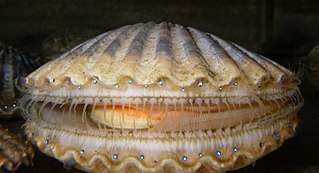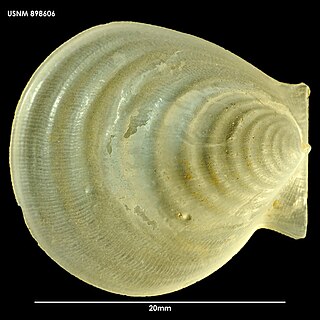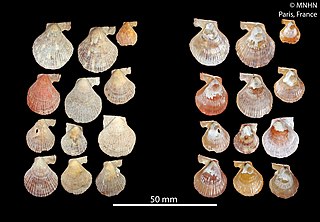
Scallop is a common name that encompasses various species of marine bivalve mollusks in the taxonomic family Pectinidae, the scallops. However, the common name "scallop" is also sometimes applied to species in other closely related families within the superfamily Pectinoidea, which also includes the thorny oysters.

The Pteriomorphia comprise a subclass of saltwater clams, marine bivalve molluscs. It contains several major orders, including the Arcida, Ostreida, Pectinida, Limida, Mytilida, and Pteriida. It also contains some extinct and probably basal families, such as the Evyanidae, Colpomyidae, Bakevelliidae, Cassianellidae, and Lithiotidae.

Vesicomyidae is a family of saltwater clams, marine bivalve molluscs in the superfamily Glossoidea.

Talochlamys zelandiae, common name the fan shell, is a species of marine bivalve mollusc in the scallop family Pectinidae.

Pleurotomella is a genus of sea snails, marine gastropod mollusks in the family Raphitomidae.
Teretia is a genus of sea snails, marine gastropod mollusks in the family Raphitomidae.

Gymnobela is a genus of sea snails, marine gastropod mollusks in the family Raphitomidae.

Bela is a genus of sea snails; marine gastropod mollusks in the family Mangeliidae.

Abra is a genus of saltwater clams, marine bivalve mollusks in the family Semelidae. Members of this genus are mostly under 1.5 centimeters long, and have thin shells which are usually white. These bivalves normally live under the surface of sandy and muddy sediments, in the neritic zone.

Hyalopecten is a genus of marine bivalve molluscs.

The Pectinoidea are a superfamily of marine bivalve molluscs, including the scallops and spiny oysters.

Euvola is a genus of marine bivalve mollusks in the family Pectinidae, the scallops. In shells of this genus, one valve is flat, and the other is deeply cupped.

Bouchetcamaena is a genus of air-breathing land snails, terrestrial pulmonate gastropod mollusks in the family Camaenidae.

Cyclochlamydidae is a family of bivalves belonging to the order Pectinida.

Pedum is a monotypic genus of bivalves belonging to the family Pectinidae. The only species is Pedum spondyloideum and it is the only genus in the tribe Pedini.

Saccella is a genus of bivalves belonging to the family Nuculanidae.

Scaeochlamys is a genus of bivalves belonging to subfamily Pedinae of the family Pectinidae.

Semipallium is a genus of bivalves belonging to subfamily Pedinae of the family Pectinidae.
Grippina is a genus of bivalves in the family Spheniopsidae which currently consists of nine species. It was first described by William Dall in 1912 with G. californica recorded in the eastern Pacific Ocean near California, US. Their habitat spans across the Pacific Ocean, mainly centering around Australia and New Zealand, though G. coronata was found in 2015 off the coast of Rio de Janeiro, Brazil in the western Atlantic Ocean. Bivalves in the genus Grippina are part of the order Anomalodesmata, also known as septibranchs, which are carnivorous clams. They use their inhalant siphons, adapted with sensory papillae to detect motion, to inhale microscopic crustaceans such as ostracods. As sessile, benthic predators, they lie in wait under sand and stick their siphons out into open water to feed. Their shells range in size from about 2–5 millimeters.

















